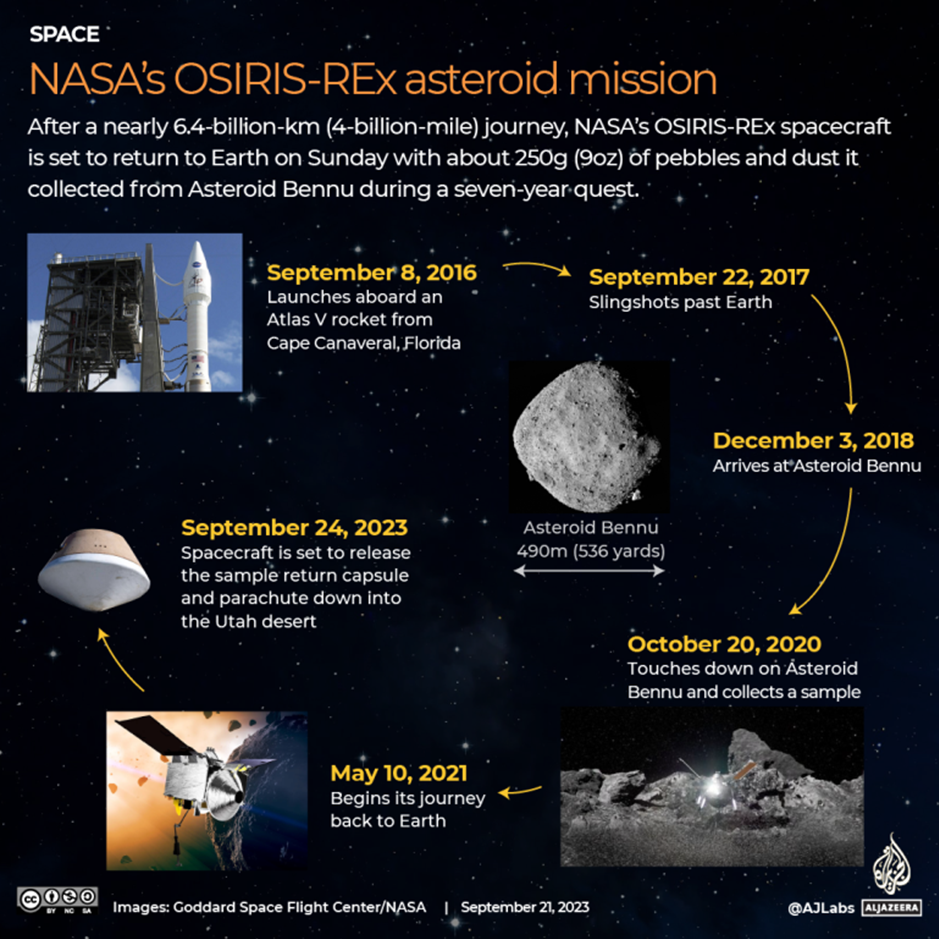ASTEROID BENNU SAMPLE BOOSTS ET LIFE THEORY
Relevance: GS 3 – Awareness in the fields of IT, Space, Computers, robotics, nano-technology, biotechnology and issues relating to intellectual property rights.
Why in the News?
- Recent findings from the study of the asteroid Bennu suggest life-forming processes are active throughout the universe.
- The discovery supports the theory that extraterrestrial life likely exists.
- This challenges the notion that life is exclusively unique to Earth.
Panspermia Theory Supported by Bennu Samples
- Samples from asteroid Bennu brought to Earth contain building blocks of life.
- This discovery strengthens the theory of panspermia.
- Panspermia suggests life exists throughout the universe and is spread by space dust, meteoroids, asteroids, and comets.
- Origins of Life on Earth:
- Panspermia theory proposes life did not begin on Earth.
- Instead, life’s building blocks were introduced to Earth by cosmic ‘carriers’ crashing into the planet.
Asteroid Bennu’s Potential Impact
- The probability of asteroid Bennu crashing into Earth is estimated at 1 in 2,700.
- NASA’s OSIRIS-Rex Mission:
- Launched in 2020, the OSIRIS-Rex mission reached asteroid Bennu.
- Samples from Bennu were collected and stored in a protected capsule.
- The capsule was precision-dropped in the Utah desert, USA, on September 24, 2023.
- Detailed Analysis of Bennu Samples:
- Initial studies of the samples indicated the presence of life’s building blocks.
- A clearer understanding was obtained from findings presented at the Lunar and Planetary Science Conference in Texas.
- The samples from Bennu contain:
- Glycine: Recognized as the simplest amino acid and a crucial component of proteins.
- Water-bearing Minerals:
- Magnetite
- Sulphites
- Olivine
- Carbonates
- These minerals are considered essential components of life’s building blocks.
Hayabusa-2 Mission and Ryugu Samples:
- In December 2020, the Japanese spacecraft Hayabusa-2 returned to Earth.
- It had collected samples from the near-Earth asteroid, Ryugu.
- In March 2023, scientists announced the findings from these samples:
- Organic Compounds: Presence of uracil, a component of ribonucleic acid (RNA), and vitamin B3.
- Carbonated Liquid Water: Found in one crystal, which also contained salts and organic matter.
Lord Kelvin’s 1871 Theory
- Lord Kelvin, renowned for discoveries like the Kelvin temperature scale, second law of thermodynamics, telegraph cables, and the galvanometer, suggested in 1871.
- At a meeting of the British Association for the Advancement of Science, he proposed that the germs of life could have been brought to Earth by meteorites.
Murchison Meteorite Discovery (1969)
- In September 1969, a meteorite exploded over Murchison town, north of Melbourne, Australia.
- Analysis of the meteorite revealed:
- It carried 74 types of amino acids.
- Eight of these amino acids are known to be involved in the formation of earthly proteins.
Latest Findings and Implications
- Recent discoveries further support the idea of life-forming processes being active throughout the universe.
- This suggests:
- Extraterrestrial life is likely to exist.
- Life is not an exclusive or erratic domain of Earth.
- It challenges the notion of Earth being the only inhabited planet, indicating that life might be more widespread in the vast universe.
Source: https://www.newindianexpress.com/editorials/2024/Mar/22/asteroid-bennu-sample-boosts-et-life-theory
Mains question
Discuss the theories of panspermia and the recent findings from asteroid samples, highlighting their implications on the existence of extraterrestrial life and the origins of life on Earth. (250 words)




